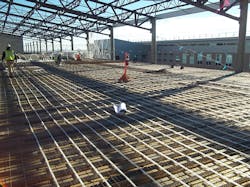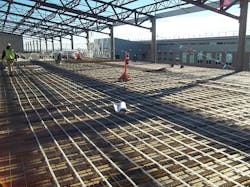CHICAGO — Playing off the title of the Star Wars saga, positive signs can be attributed to hydronics’ niche market for 2017, as economic indicators seem favorable to start the year, although the market, in part, hinges on a possible wait-and-see approach with President-elect Donald Trump taking office.
Speaking of the presidential race, “Based on what I am seeing in the stock market post-election, I think the construction industry in general is in for a good ride,” said Mark Eatherton, executive director of the Radiant Professionals Alliance (RPA).
“Here in Denver, Colorado, we have one of the most robust economies in the nation and a current housing shortage,” said William Frew, owner/vice president, Sunshine Plumbing Heating Air. Fellow Denver resident Eatherton concurred, “We are seeing a huge boom and increase in population, and the construction of multi-family dwellings is breaking records. New housing starts are booming, and remodels are off the charts as well.” Granted, there are pockets in the country that are performing better than others.
Yet, a spike in residential construction, in theory, equates to more product being moved. “We’re confident that an uptick in new residential construction will continue to boost demand for new water heating products. A considerable part of this growth is expected to be in multi-housing projects,” said Carl A. Pinto Jr., director of marketing, Bradford White Corp.
Also, said Pinto, all indications are that replacement market trends will be on par with last year, providing water heater manufacturers ample opportunities for growth. Many reports suggest that this positive trend is expected to continue out through at least 2021.
Some industry experts take the glass-half-full approach and see the radiant market on the rise. “I would estimate that we will continue to see steady growth in the radiant market in 2017. The residential market is projected to have good growth over the next couple of years. In addition, unemployment is projected to remain low,” said David Desjardins, product manager for Heating and Cooling, Viega.
Many indicators point toward the residential construction market continuing to see modest growth over the next few years.— Mark Eatherton
The residential hydronics market is closely tied to new construction; i.e., single-family starts. “Many indicators point toward the residential construction market continuing to see modest growth over the next few years. Therefore, it is highly probable that the residential hydronics market will see similar modest growth during this same period,” said Mark Hudoba, director of Heating and Cooling, Uponor.
Other experts, on the other hand, take a more reticent approach. “The residential hydronics industry hasn’t been growing for years — if not in a small decline — and we see no trend that’s going to alter its course in the short term,” said Mark Chaffee, vice president of Governmental Relations & Sustainability, Taco Comfort Solutions.
Energy-efficiency bolsters commercial hydronics
The increased demand for sustainable and energy efficient commercial buildings continues, which contributes to the higher growth rate in the commercial hydronics market.— Mark Hudoba
The commercial hydronics market is slightly outpacing the overall commercial building market, which is seeing modest gains, as the U.S. economy remains strong. Most experts are in agreement when it comes to the commercial hydronics market due to the influential nature of energy efficient buildings. “The increased demand for sustainable and energy efficient commercial buildings continues, which contributes to the higher growth rate in the commercial hydronics market. That is because the primary benefit of hydronics over other options for HVAC in a commercial building is energy efficiency,” said Hudoba.
The trend to incorporate radiant in efficient/Net Zero buildings in specific markets is still strong. According to Chaffee, a recent study released by the Continental Automated Buildings Association (CABA) on Zero Net Energy Buildings shows that 64 percent of the buildings used radiant systems: 52 percent used radiant heating, and 35 percent used radiant cooling. This represents a very substantial increase compared to the overall building market where hydronics has about nine percent share of the total HVAC installations. “As we go green, we go hydronic,” said Chaffee. “Water is the natural choice.”
Derek Bower, product management for metals, Viega, concurs with the overall efficiency equal economy boost assessment, saying that the outlook continues to be positive because manufacturers and business owners have increasingly realized the advantages of increased efficiencies and environmental stewardship.
For these reasons, we also expect an uptick in value engineered, multi-boiler commercial hybrid systems that combine condensing technology with near-condensing technology.— Chuck O’Donnell
Laars Heating Systems Co.’s director of marketing, Chuck O’Donnell, sees the major economic driver as the desire for higher-efficiency products as current equipment meets end-of-life status. “However, there may be more of a focus on installation ‘first costs’ as well as long-term operational costs” said O’Donnell. “For these reasons, we also expect an uptick in value engineered, multi-boiler commercial hybrid systems that combine condensing technology with near-condensing technology.”
Furthermore, Sunshine’s Frew said that because there is such an influx of people moving into older homes in the Denver area, for example, they are facing tough choices when realizing they have purchased a home with a 35-year-old boiler. “The millennial buyers — and others — have a strong moral focus on the environment and are seeking more energy efficient systems. This opens the way for combi units and high efficiency systems,” said Frew.
Consumer confidence
Disposable income growth will also be a factor as consumers look to purchase newer, more efficient water heating products — even before their current products have actually reached their lifespan. “So, we should begin to see more discretionary spending, versus emergency replacement purchases,” said Pinto.
“I think consumer confidence is at an all-time high, and there are a lot of retiring Baby Boomers who are making their retirement nest secure and comfortable for the future,” said Eatherton.
O’Donnell also expects gains in consumer confidence coupled with increased disposable incomes to drive sales in the residential markets. Part of this will stem from continued interest in and purchasing of high efficiency products, says O’Donnell.
New administration
Oh, and about that election. What affect will that have on the regulatory process moving forward? In a nutshell, if the new administration sticks to its words, the regulatory process is in for an overhaul, said Mark Riso, vice president of Government Relations, PHCC — National Association.
According to Riso, there will be a tremendous emphasis on making sure that an agency follows a process, which takes into consideration the economic impact of a regulation. If a regulation impacts jobs or job creation, it’s going nowhere. Regulatory accountability and regulatory flexibility will be prominent for the next few years. “I am often asked about regulations impacting contractors, but the regulations impacting this industry are more about small business,” said Riso.
Chaffee, who follows the goings on in Washington closely, said that with Rick Perry, the former governor of Texas, and President-elect Trump’s choice to lead the Department of Energy, it should get interesting on the regulatory front.
While running for president himself in 2011, Perry said that he wanted to eliminate the department. “Who knows how far Trump’s agenda will extend into the HVAC world, but one thing for sure is that he’s committed to major changes to the energy policy. Among the most prominent changes is Trump’s plan to eliminate much of the red tape created by the thousands of new regulations put in place during the Obama administration,” said Chaffee.
According to Dan Foley, owner, Foley Mechanical, Lorton, Virginia, with any new administration, houses will turnover and remodeling and upgrades will ensue. “Money always flows through D.C. New administrations always bring in new business for us,” said Foley.
Yet Foley doesn’t see the incoming administration extending renewable tax credit such as geothermal. “They will need to be sold on their merits alone, without the 30 percent uncapped federal subsidy,” said Foley.
In addition, the 90 percent furnace rule will have a huge impact as it is written now. If not modified, Foley believes that you will see old systems repaired rather than replaced. Gas furnaces will be replaced with heat pumps in milder climates. Alternative heating systems such as space heaters, mini-splits and room heaters may replace central gas furnaces. “This ruling may have the exact opposite of the intended result,” said Foley.
In the end, it’s all speculative at this point as to whether the new administration will have an immediate impact. “No one has a crystal ball to see into the future, so we can only speculate how the incoming administration’s policies and positions could impact the market,” said Hudoba. “Overall, I think the administration will have a limited effect on the growth of the hydronics industry.
“However, one could speculate that the administration’s business-friendliness and increased infrastructure investments could bolster new-commercial construction,” added Hudoba. “On the flip side, one could also speculate that less focus on green and energy conservation could negatively impact the hydronics market, as one of the primary benefits of a hydronics system over other commercial HVAC systems is energy efficiency.”
The market demand for energy efficiency will remain strong, continued Hudoba, and that demand will continue to fuel the growth of the hydronics industry, regardless of the policies of the incoming administration.

